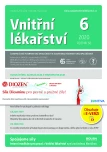What is new for internists in the updated guidelines on the diagnosis and management of pulmonary embolism 2019?
Authors:
Zdeněk Monhart
Authors‘ workplace:
Interní oddělení Nemocnice Znojmo
Published in:
Vnitř Lék 2020; 66(6): 386-390
Category:
In Brief
Overview
The new guidelines on the diagnosis and management of pulmonary embolism developed in collaboration with the European Respiratory Society were presented on the congress od European society of cardiology in 2019. Are internists concerned, when these guidelines were presented at the congress of cardiologic society? Management of acute pulmonary embolism is less „cathlab dependent“than management of acute coronary syndromes – and pulmonary embolism patients are often treated by internists. Moreover, differential diagnosis of dyspnoea is a everyday problem solved by internists. What is new in the updated guidelines? Refinements in interpretation of D‑dimer testing will help us to avoid unnecessary pulmonary angiograms. Non‑vitamin K antagonist oral anticoagulants (NOACs) are now the preferred agents for treating the majority of patients with PE, both in the acute phase and over the long term, including selected patients with malignancy. Further important updates include recurrence scores and guidance on extended anticoagulation after PE. A new comprehensive algorithm is proposed for patient follow‑up after acute PE to prevent, detect and treat late sequelae of venous thromboembolism.
Keywords:
secondary prevention – guidelines – Pulmonary embolism – anticoagulation therapy
Sources
1. Righini M, Van Es J, Den Exter PL, et al. Age ‑adjusted Ddimer cutoff levels to rule out pulmonary embolism: the ADJUST ‑PE study. JAMA 2014; 311 : 1117–1124.
2. van der Hulle T, Cheung WY, Kooij S, et al. Years Study Group. Simplified diagnostic management of suspected pulmonary embolism (the YEARS study): a prospective, multicentre, cohort study. Lancet 2017; 390 : 289–297.
3. Konstantinides SV, Meyer G, et al. The 2019 ESC Guidelines on the Diagnosis and Management of Acute Pulmonary Embolism. Eur Heart J. 2019 Nov 1; 40(42): 3453–3455.
4. Zondag W, Mos IC, Creemers ‑Schild D, et al. Outpatient treatment in patients with acute pulmonary embolism: the Hestia Study. J Thromb Haemost 2011; 9 : 1500–1507.
5. Raskob GE, van Es N, Verhamme P, Carrier M, et al; Hokusai VTE Cancer Investigators. Edoxaban for the treatment of cancer ‑associated venous thromboembolism. N Engl J Med 2018; 378 : 615–624.
6. Young AM, Marshall A, Thirlwall J, et al. Comparison of an oral factor Xa inhibitor with low molecular weight heparin in patients with cancer with venous thromboembolism: results of a randomized trial (SELECT‑D). J Clin Oncol 2018; 36 : 2017–2023.
Labels
Diabetology Endocrinology Internal medicineArticle was published in
Internal Medicine

2020 Issue 6
Most read in this issue
- Myocardial infarction or broken heart syndrome?
- Gastrointestinal tract involvement in mixed connective tissue disease (Sharp syndrome)
- Food allergy and intolerance
- Complement deficiencies
